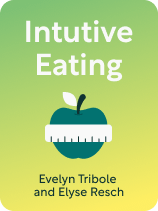

This article is an excerpt from the Shortform book guide to "Intuitive Eating" by Evelyn Tribole and Elyse Resch. Shortform has the world's best summaries and analyses of books you should be reading.
Like this article? Sign up for a free trial here.
Is exercise a boring chore you have to push through? How can you enjoy working out?
Intuitive Eating by Evelyn Tribole and Elyse Resch explores how exercise, and finding joy in moving your body, can enhance your relationship with food. The number one strategy they recommend is changing your attitude about exercise.
Read below to learn how to enjoy working out so you can improve your relationship with your body and food.
Find Joy in Moving Your Body
Learning how to enjoy working out provides numerous health benefits, such as enhancing mood, boosting energy levels, improving cardiovascular health, and increasing strength and flexibility. However, Tribole and Resch say that when you have an uncomfortable relationship with food, you may also have an uncomfortable relationship with exercise. You might view it as a punishment for eating and feel the need to overcompensate with extra workouts after indulging in treats. This negative association can affect both your relationship with food and your motivation to engage in and benefit from regular exercise.
(Shortform note: Michael Matthews (Bigger Leaner Stronger) suggests that the inverse is also true: Some people use exercise to justify indulging in unhealthy eating habits, thinking they’ve earned the right to eat junk food after completing a workout. To counter this moral licensing, Matthews suggests applying the same approach to exercise as Tribole and Resch advise for food: Stop labeling your actions as good or bad. Instead, shift your focus to the overall benefits of exercise. By embracing a more balanced perspective, you can cultivate a healthier relationship with both food and physical activity.)
Change Your Attitude Toward Exercise
To improve your relationship with exercise and stay motivated, the authors suggest approaching it as a source of pleasure and fulfillment, rather than as a punishment or obligation. They provide five guidelines for changing your attitude toward exercise:
1) Shift from viewing exercise solely as a means to burn calories or change your body shape to recognizing its positive impact on your mood, energy levels, and overall well-being.
(Shortform note: Research suggests that avoiding fitness content aimed at altering appearance can help change your perspective and increase your motivation to exercise. Several studies reveal that seeking inspiration from this type of content may, in fact, decrease your motivation to exercise and leave you feeling more dissatisfied with your body. This is particularly true for people who want to exercise to achieve a certain appearance rather than to achieve a state of health.)
2) Explore various forms of exercise to find what resonates with you the most, and engage in spontaneous movement that feels good to you, without the pressure of adhering to a strict exercise regimen.
(Shortform note: While allowing room for spontaneity is important, experts suggest focusing on four key types of exercise to ensure comprehensive well-being: aerobic exercises for cardiovascular health, strength training to build and tone muscles, flexibility exercises to improve range of motion, and balance exercises to reduce the risk of falls. Contrary to the misconception that structured routines limit variety, incorporating these four areas will provide numerous opportunities to inject spontaneity and different exercises into your workouts. You can explore different activities, try new exercises, or adapt your routine to suit your mood and preferences, making your fitness routine enjoyable, diverse, and sustainable.)
3) Invite others to join you in your physical activities, as shared experiences can make the process more enjoyable and motivating.
(Shortform note: Studies support this suggestion, revealing that working out with others significantly boosts motivation to exercise for various reasons. When you commit to exercising with others, positive peer pressure, support, and encouragement naturally come into play, creating an uplifting environment. Additionally, having a workout partner enhances accountability, reducing the inclination to skip sessions. And finally, friendly competition pushes you to do your best, especially when exercising with fitter individuals. This atmosphere of camaraderie and challenge makes the experience more enjoyable, helps you release more endorphins, and leaves you eagerly anticipating the next workout.)
4) Set achievable milestones, celebrate your progress, and avoid unrealistic fitness goals that may lead to burnout or disappointment.
(Shortform note: Experts offer a five-step process for setting and achieving realistic fitness goals: 1) Assess your current fitness level by considering strength, endurance, flexibility, and cardiovascular health to set appropriate goals. 2) Identify your priorities, such as muscle gain, flexibility, or overall health, to set specific objectives. 3) Use the SMART framework for goals: Specific, Measurable, Attainable, Relevant, and Time-bound (for example, aim to walk for 30 minutes three times a week). 4) Break long-term goals into manageable milestones, enabling you to celebrate small victories along the way. 5) Maintain motivation and accountability by tracking your progress with workout records, measurements, and achievements.)
5) Remember that you’re not obligated to exercise. You can always choose to take breaks when needed.
(Shortform note: Fitness experts suggest that taking well-timed breaks can benefit you in four ways, by helping you: 1) Avoid overexertion—allowing your body to rest prevents excessive strain, enabling you to improve your fitness levels when resuming workouts. 2) Combat stress overload—exercise itself can cause mental stress. Resting helps counter the negative effects of stress, particularly when cortisol levels are high. 3) Recharge motivation—taking a break from constant discipline prevents willpower depletion, helping you stay focused on your fitness goals. 4) Enhance performance—prioritizing breaks can help optimize your physical and mental capabilities, leading to improved performance in your workouts and daily activities.)

———End of Preview———
Like what you just read? Read the rest of the world's best book summary and analysis of Evelyn Tribole and Elyse Resch's "Intuitive Eating" at Shortform.
Here's what you'll find in our full Intuitive Eating summary:
- Why eating is often associated with guilt, shame, and fear
- How diets damage your relationship with food
- Ways to cultivate a healthy relationship with food






